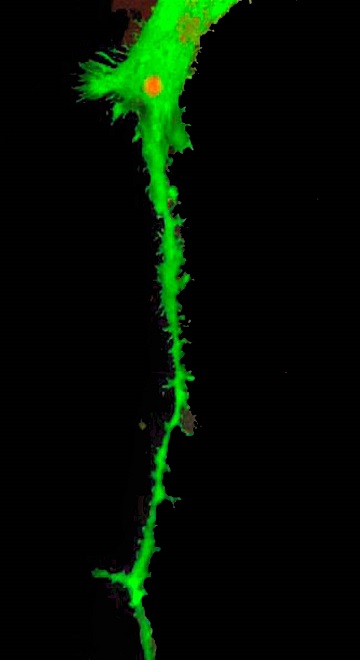Nerve and Spinal Cord Injury
Nerve injury can be catastrophic. The human body is designed to survive great trauma and has a complex response system to stop severe bleeding and stabilize damaged tissues. However, these mechanisms that involve the inflammatory process result in subsequent scar formation that can interfere with long term regeneration of normal tissue. Nowhere is this more apparent than in the nervous system.
Many people are familiar with peripheral nervous system injury, where small insults—a cut finger, a shallow burn—can result in a life-long loss of normal sensation. More serious injuries to the central nervous system have more serious consequences, the most severe of which are paralysis and cognitive impairment. Injuries to the central nervous system are common, both among soldiers on the battlefield and everyday civilians. There are 12,000 cases of spinal cord injury occurring annually in the United States, and approximately 200,000 spinal cord injury survivors live with a permanent disability.
Nerve injury
Less than 1% of patients with significant spinal cord injury recover complete neurologic function. Blunt trauma, also known as contusion (or bruising), is the most common form of severe brain and spinal cord injury. Though the initial injury causes serious harm, recent research suggests that the body's response to injury can be even more damaging. Swelling, which increases pressure and prevents proper circulation, and the secondary inflammatory response, which introduces immune cells and scarring into the central nervous system, are the primary culprits. Many cells die from lack of oxygen and nutrients during swelling, and immune cells that cross the blood brain barrier may remain for weeks, actively promoting fibrosis (scarring) and impeding the regrowth of nervous tissues. Months later, the result of a serious contusion injury is the formation of a thick scar, which prevents regeneration and makes deficit permanent.

Our approach to the challenge
In order to overcome the difficult challenges of neurologic injury, the CRM is working both to jump-start regeneration in patients suffering chronic deficits, and to develop novel treatments to prevent neurologic damage from occurring in the acute phase.
In our effort to combat chronic neurologic deficit, we are excited to announce the impending launch of two clinical trials to investigate neuro-regenerative effects of the Portable Neuromodulation Stimulator (PoNSTM) device to improve chronic disability for both traumatic brain injury (TBI) and spinal cord injury (SCI). The PoNSTM is a simple and non-invasive device which is worn on the tongue and directly stimulates the central nervous system with small amounts of electricity. Stimulation helps form new synaptic connections and potentially jump-starts recovery in people suffering chronic deficit. More information about the device itself can be found on the manufacturer's website.
During 2015, our CRM/VA collaborative team will be one of three centers funded by Helius Medical Technologies and the US Army Medical Research and Materiel Command to investigate the PoNSTM device for treating TBI. We are also leading a clinical trial to investigate the PoNSTM for treating SCI. The PoNSTM may promote synaptic regeneration and to reduces paralysis and neurological deterioration by stimulating neurons and encouraging the growth of new synaptic connections. Its efficacy has been previously demonstrated in patients with Multiple Sclerosis. More information about the PoNSTM device can be found here.
In addition to the PoNSTM, our ongoing pre-clinical nerve research investigates the acute or early phase of spinal cord injury and the use of cell therapy to provide therapeutic benefit. Our research explores an entirely new approach to post-injury treatment;using adult stem cells and stem-cell-mediated proteins to reduce swelling and prevent breakdown of the blood-brain barrier, thereby avoiding much of the deterioration and damage that occurs after injury. The powerful stem cells used in this type of cell therapy are naturally able to modulate the body's immune response, preventing damaging effects (inflammation) and scarring without altering the ability to fight infection. We are in the middle of conducting pre-clinical trials, and are beginning to see exciting results.
In the peripheral nervous system, we have focused on the therapeutic potential of Schwann cells to jump start recovery. Schwann cells are a vital part of the peripheral nervous system, they nourish and repair nerves, and provide the myelin lining to speed signal conduction. One of our senior scientists has published research showing that we can take bone marrow cells and transform them into these useful Schwann cells—a discovery that may lead to injection of the cells into injured nerves to facilitate regeneration in peripheral nerves that have been damaged due to acute spinal cord injury, limb compartment syndrome, or diseases like diabetes and multiple sclerosis.
Complete therapy
By developing both cell-focused treatments to prevent damage and device-assisted neuro-rehabilitation technologies, we plan to eventually combine these approaches to dramatically improve the treatment and outcomes of patients faced with neurologic injury. We hope that the benefits of stimulatory technology like the PoNSTM can be coupled with cell therapy and yield a synergistic effect for enhanced recovery.